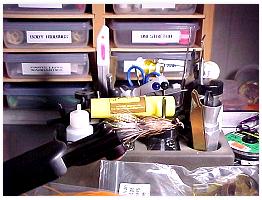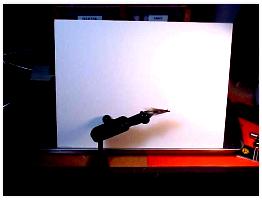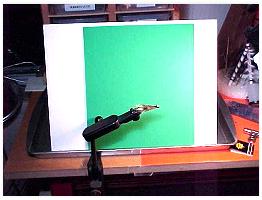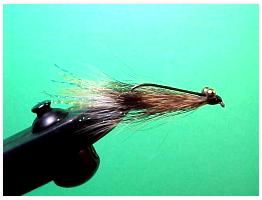
Look at this mess! It is very hard to tell where the fly ends and the clutter begins!
Let's face it, you can't perform many of the intricate procedures necessary
to tie a great fly if you can't see what you are doing. You might have a tough
time blindfolded too, though at least then mediocre results would be
understandable.
Most of us sit down at our tying bench and just begin to create, without
any regard for the easiest thing we can do to improve the quality of our
day-to-day flies. That being to separate the fly from the background.
Next time you see one of those interesting excursions into the human
anatomy that the TV folks arrange for you at the precise time you are
attempting to eat your dinner, take note of the surgeons' preparation.
They are very fastidious about preparing the patient to be operated
upon. They do not want distractions, hence the very carefully isolate
the area of interest with sheets prepared for the purpose of blocking
out the things they do not want to see. Some even have little 'portholes'
cut into them to isolate the area of interest.
Now we are not going to equate fly tying with surgery, but we can
learn from the observation!
Looking through catalogues you can find a specially made device
called a profile plate. This typically attaches to the vice stem and
holds by various means a piece of cardboard or plastic, which acts
as a background to isolate your fly. The more common ones are
about $25.00 to $35.00. With additional plates in additional colors
available, but not very readily, at an additional cost.
Now if you have the money and want a factory job that is fine. Get it
ordered now! Your eyes will surely appreciate the thoughtfulness of
your purse.
If you are like the legions of us who simply do not want our hard-earned
dollars going for another tool, listen up, this is very easy. Within one
half hour of reading this you will have a profile board which will be
the cheapest investment you have ever made in preserving your eyesight.
Now in the picture below, a simple piece of foam mounting board
has been placed between the fly, and the above pictured tool block.
In fact the tool block is holding it against the front edge of the tray.
(If you don't have a tray on your bench get one, it will save your
bacon in more ways than one!) If you haven't read,
Getting Organized,
now is the time of year to do so!
You need not use anything as glamorous as the mounting board shown.
Cut a piece of cardboard out of the side of a corrugated box instead.
We are not playing 'he who spends the most wins' here. There are, as
in many other things, many ways to "skin the cat."

An immediate improvement to the stark white or dull brown of
your background would be the addition of a color that contrasts
with your fly, or is complimentary if you prefer. These colors are
usually gray or green, but certainly almost anything you like will work.
Avoid fluorescent heliotrope however, which was popularized in
Haight Asbury many years ago by the disciples of a Dr. Timothy
Leary, it will cause you to tie some very innovative creations indeed.
A tablet of construction paper like you used as a kid for school
projects will give you all of the background colors you will ever need.

Now we can see the details in the fly!

Since we can now see the details, we can see those things in our tying
which need improvement, as well as those that we have done correctly.
Seeing the fly well is the single most important thing that differentiates
a ho-hum tier from a good tier.
It would be hard to find a better, or more easily executed tying tip!
After all, isn't that why we all read columns like this, and spend
countless hours at our vices?
If you have any tips or techniques, send them along, most of this
material has been stolen from somebody, might as well steal your ideas
too!~ George E. Emanuel
(Chat Room Host Muddler)
|









